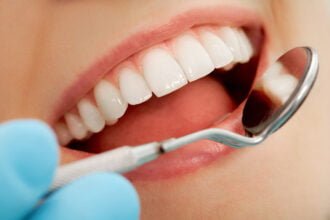Your mouth contains over 6 billion bacteria. Some of these bacteria promote health, while others provoke disease when left uncontrolled. Dental hygiene is of the highest importance if you want to maintain healthy gums and teeth and to control these bacteria in your mouth.
Proper oral hygiene can contribute to shining and radiantly white teeth. It can also contribute to healthy teeth, which is free of unsightly and irritating discoloration and staining.
If you take care of your teeth, you can prevent cavities, gum diseases, and tooth sensitivity. Regular brushing and flossing may prevent gum disease and reduce your risk of cavities. Also, it’s important that you have regular checkups with your dentist. To learn more dental procedures that you should do to care for your teeth properly, you can visit familydentalhealth.com.
Understanding The Anatomy Of The Mouth
The mouth is important not just for speech but also for a very complex receptacle for food and the gastrointestinal system. The mouth has four parts: the upper, middle, lower teeth, and the gums. A human’s mouth typical anatomy consists of the oral cavity, the soft and hard palates, mucosal tissue–soft tissues that cover the upper and the lower parts of the face and the inner lips– and the gums. The tongue is also present and is found between the teeth or inside the gums.
The mouth contains over 500 types of bacteria. The most common bacteria found in our mouths are Lactobacillus acidophilus, which plays a critical role in saliva production. Antibiotics and diseases, such as diabetes, can affect your pH balance, making the conditions in your mouth worse, leading to gum disease, tooth decay, and even bad breath.
Bacteria levels in the mouth widely vary, depending on several factors, including genetics, environment, and diet. The presence or absence of antibiotics can also significantly impact the bacteria’s levels in your mouth. The mouth has a complex system for keeping track of its bacteria.
Anatomy Of The Tooth
The anatomy of teeth is very intricate than its visual appearance. The tooth has these major parts:
1. Root
Tooth roots are the connections between the teeth and gums. The root supports the tooth from the gum line up to the crown.
When the tooth’s roots become infected and untreated, many severe oral health issues, such as gum disease, aesthetic, or functional difficulties, can develop. The infection of the tooth’s roots may be caused by a wide variety of bacterial infections, fungal infection, viral infection, trauma to the root canal, abnormal growth of abnormal cells, such as cancer, or a structural defect in the tooth. Most of these infections will go away independently, but the infection can progress to more serious stages if not treated.
2. Crown
This is the visible part of the tooth, and it’s covered with a protective layer called the enamel. When the crown is damaged, dentists can replace it with a dental cap to protect the layers beneath it.
When a tooth has been severely impacted or damaged by a direct blow or accident, an artificial tooth crown may also be used. Dental crowns are often used after cosmetic surgery and when a badly chipped tooth is difficult to fix.
A dental crown may help restore the lost tooth and protect it from further injury and damage. A crown will also prevent further damage to the surrounding teeth and may prevent the formation of tooth decay that can spread to the adjacent teeth. It can also be used to cover the tooth if it becomes discolored or if it has become infected.
Within the root and crown, you’ll find the following parts:
- Enamel: The enamel in your teeth is the most highly crystallized material in the body. It is made up of a hard outer surface called dentin and a softer inner core called the pulp.
When your tooth is damaged or worn away from constant wear and tear, it causes the dentin to harden and the pulp becomes less effective in protecting your teeth and gums. If this happens over time, it can lead to cavities or other problems, such as infection, gum disease, or bone loss. This is why the tooth’s enamel is so important and why proper care should be done at all times.
- Dentin: The dentin is found under the enamel and cementum. It contains small tubules or small hollow tubes. When the enamel is damaged, the tubules allow heat, acid, or other foods to stimulate the nerves, causing sensitivity.
What Happens When You Ignore Dental Health
There are detrimental effects when you ignore your dental health. Numerous studies reveal that there’s a relation between dental health and the overall health of a person.
Here are important reasons why your dental health should never be overlooked:
1. Gum Disease
Gum disease can be very painful, and it’ll also cost you quite a bit of money to treat it. Gum disease is usually caused by a buildup of tartar on the teeth.
Tartar is an abnormal hardened plaque that contains bacteria. Some normal bacteria within tartar are beneficial, but others are potentially harmful to your teeth’s health.
2. Oral Cancer
Oral cancer can occur in any part of the mouth. Most cancers occur in the oral cavity where the tissues are located. Oral cancer is also divided into two types: those that occur inside the mouth (lips, cheeks, gums, and teeth) and those that occur outside the mouth (the roof and walls of the mouth, the back of your throat, and the roof and walls of your mouth).
Smoking can lead to the development of oral cancer. Another cause of oral cancer is poor dental hygiene.
The treatment for oral cancer varies with each type. Most cases that have been diagnosed are in their early stages. This means that the tumor hasn’t spread to another part of the body yet. In this case, surgery would be the best recourse.
Symptoms of oral cancer include,
- Bleeding gums
- Pain in or around your teeth
- Loss of taste in the mouth
- Swelling or hardness around the mouth
- Soreness around the gum area
- Pain or discomfort when chewing food
- Fever or chills
- Swollen glands in or around the mouth
- Coughing or difficulty breathing
- Hoarseness
Symptoms of oral cancer also vary depending on the part of the mouth affected. For example, symptoms in the mouth and neck region may be different from those in the upper lip or behind the gums. In the case of oral cancer in the oropharynx, it’s important to look for signs of unusual changes in the soft tissue’s shape, which is around the mouth or throat.
3. Tooth Decay
Dental decay results from a buildup of food and bacteria on the teeth and gums, which may cause tartar to form and can ultimately cause tooth decay. One of the most common forms of tooth decay is caused by smoking since tobacco contains a chemical called tar. Teeth are more likely to decay when people smoke because tar will stain the teeth, and if it’s not treated with special kinds of toothpaste and fluoride, the stains can become permanent.
Other factors that contribute to tooth decay include poor dental hygiene, an insufficient level of calcium in the diet, and drinking plenty of soda, which is acidic. It’s best to brush your teeth twice a day, even more if you’re a smoker, as this will help keep the enamel healthy.
If you’re prone to cavities, you should regularly have your gums examined for any changes or abnormalities. You should also visit your dentist for regular dental checkups. Regular cleaning and treatment will ensure that your teeth stay healthy.
4. Risk Of Heart Disease
Heart disease may happen in many different ways–from high cholesterol to smoking. It can also occur from dental issues, such as cavities, periodontal disease, abscesses, and gum disease.
Various studies have been conducted regarding this matter. Here are some theories experts proposed:
- Bacteria infecting the gums that cause gingivitis and gum disease travels to the blood vessels and infect other parts of the body. These bacteria may cause blood vessel inflammation and tiny blood clots, which may cause heart attacks.
This idea was supported when researchers found remnants of oral bacteria within the atherosclerotic blood vessels despite being far from the mouth.
- Gum diseases and other dental health problems may cause the body’s immune system to respond to weakening and inflammation. This sets off a series of cardiovascular damage throughout the body, which includes the brain and heart.
Proper Care For Dental Health
Proper dental health is a very important aspect of keeping your teeth healthy and looking beautiful. Many different factors affect your dental health and some dental problems may not be noticed immediately. This is the reason why you should regularly visit your dentist for checkup or cleaning.
Luckily, with proper dental care and a regular oral hygiene routine, you can achieve a beautiful smile and healthy teeth.
1. Go To Dentist For Regular Cleaning
Regular visits to your dentist are necessary to maintain proper dental hygiene. Dentists will recommend special kinds of toothpaste, mouthwashes, and rinses, which may prevent tooth decay.
When plaque buildup starts to cause oral problems, the dentist will recommend a scaling dental treatment. This procedure is done by removing excess plaque and tartar with instruments. However, there are times when your tooth is unable to absorb the acids in the plaque and tartar. This means that the tooth will have to be removed by an oral surgeon.
2. Never Overlook Dental Issues
If your teeth begin to show signs of decay, such as cavities, a dentist will often use a powerful laser beam to treat the underlying gum tissue and treat the teeth’s root. This process of teeth whitening and restoration may completely remove the discolored appearance.
Dental implants offer the most effective, permanent solutions for tooth decay. By aligning the teeth, it may help restore its natural form. There are two types of dental implants: fixed or removable, each of which has its advantages and disadvantages. An implant can last as long as ten years, while a removable denture doesn’t.
3. Change Your Diet
When there’s an accumulation of plaque on the teeth, there can be many causes, including teeth grinding, smoking, drinking coffee or tea, and even food consumption. Changing your diet and avoiding the food items that cause tooth decay and other problems will help prevent future problems. Drinking water that contains fluoride may also help prevent tooth decay and other problems related to aging.
Eating foods that contain plenty of calcium may help you maintain healthy teeth as well. By eating foods, such as yogurt and cherries, you’ll find that your teeth will retain more of the nutrients that are present in these fruits. This may also help prevent cavities from forming and will help prevent tooth decay in the future.
4. Proper Dental Hygiene
Many of the problems associated with tooth decay are caused by poor oral health habits and a lack of daily brushing and flossing. If you brush and floss regularly, you’ll find that you get fewer cavities and have more healthy-looking teeth.
Teeth cleaning kits can also be purchased that won’t only get rid of plaque and other problems, but will also remove any discoloration from stained teeth. This product may also be used simultaneously with your natural teeth whitening products. Lastly, this product is easy to use and is inexpensive.
Summary
Understanding the anatomy of the mouth and teeth will help you realize the importance of maintaining good dental health. When you don’t brush your teeth or visit the dentist regularly, you’ll damage the tooth’s important parts like the enamel. When the teeth’ protective layer is destroyed, you can expect bacteria to enter the gums and tissues underneath the teeth.
Your dental health is connected to overall health. Tooth cavities aren’t only bad to look at, but they’re also extremely painful and may cause various diseases. It’s important that you brush your teeth regularly and also maintain a balanced and healthy diet. Lastly, and as mentioned before, don’t forget to visit your dentist for regular checkups and cleaning.









